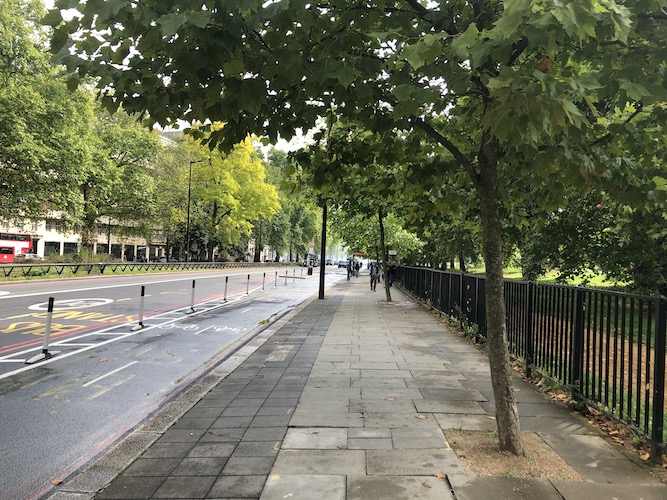I like the picture of Park Lane painted by Nicholas Boys Smith in No Free Parking:
“Had you been riding down Park Lane in the early summer of 1861 or 1862, where the traffic now thunders, you might have seen crossing your path, followed by grooms and by titled admirers, a dashing and very young equestrienne riding side-saddle, exquisitely dressed, nodding to the passing gentlemen, by turn holding her hands behind her back or artfully leaning over to the compliments of a walking admirer.”
This young woman was Catherine Walters, known as “Skittles”, a Liverpudlian and high end courtesan who, Boys Smith tells us, went on to become “the darling of the London scene”. As for Park Lane, it was in those days “where bucolic charm met urban fashion” – a very different avenue from what it has become.
The subtitle of Boys Smith’s chapter about it, “Rotten road”, might be applicable to other periods of Park Lane’s history, including way back when it was leafy Tyburn Lane and eased the passage of those travelling north to gawp at hangings. But its rottenness today is attributed to what Boys Smith calls “the most destructive act of road widening in London’s history”, by which he means Park Lane’s conversion during the early 1960s into today’s fat dual carriageway, requiring 20 acres to be sliced off Hyde Park.
Various radical remedies have been proposed for its noise, congestion and pollution. In 1990, Westminster councillor Peter Martindale suggested to colleagues it should be diverted below ground and the road space liberated for development into a pleasing boulevard. In 2012, Boris Johnson echoed the idea of putting it into a tunnel. A nation is shocked that no such thing has occurred. A quarrelsome jury remains out where the most recent redesign of the road itself is concerned.
For the foreseeable future, then, Park Lane seems stuck with a reputation as the worst sort of urban freeway, a classic mid-20th Century transport planning error that won’t be easily or cheaply put right. It will make a brief appearance in my very imminent novel, with two characters who walk from Hyde Park into Mayfair crossing a “creeping, grumbling Park Lane traffic jam” as they progress from the second most expensive square on the Monopoly board to the most expensive of all.
I cannot claim to be the first to recruit its unattractiveness to the cause of fiction. Alan Hollinghurst’s fabulous The Line of Beauty, first published in 2004, described three guys in an open-topped sports car negotiating it in the mid-1980s.
“…half an hour later they were creeping down Park Lane. The decisive plunge from the heights [of Highgate] had slowed and stalled in the inexhaustible confusion of traffic and roadworks and construction. The wolfish bites had turning into thwarted snaps, the squeals of half a dozen near-collisions. Shuddering lorries squeezed them and dared them and flushed their reeking fumes through the coverless car, as four lanes funnelled into one outside the Hilton Hotel.”
Nearly four decades on, Park Lane, like the traffic that crawls along it, still isn’t going anywhere fast.
John Vane’s novel Frightgeist will go on sale later this month. Follow John on Twitter.
On London strives to provide more of the kind of journalism the capital city needs. Become a supporter for just £5 a month. You will even get things for your money. Learn more here.
